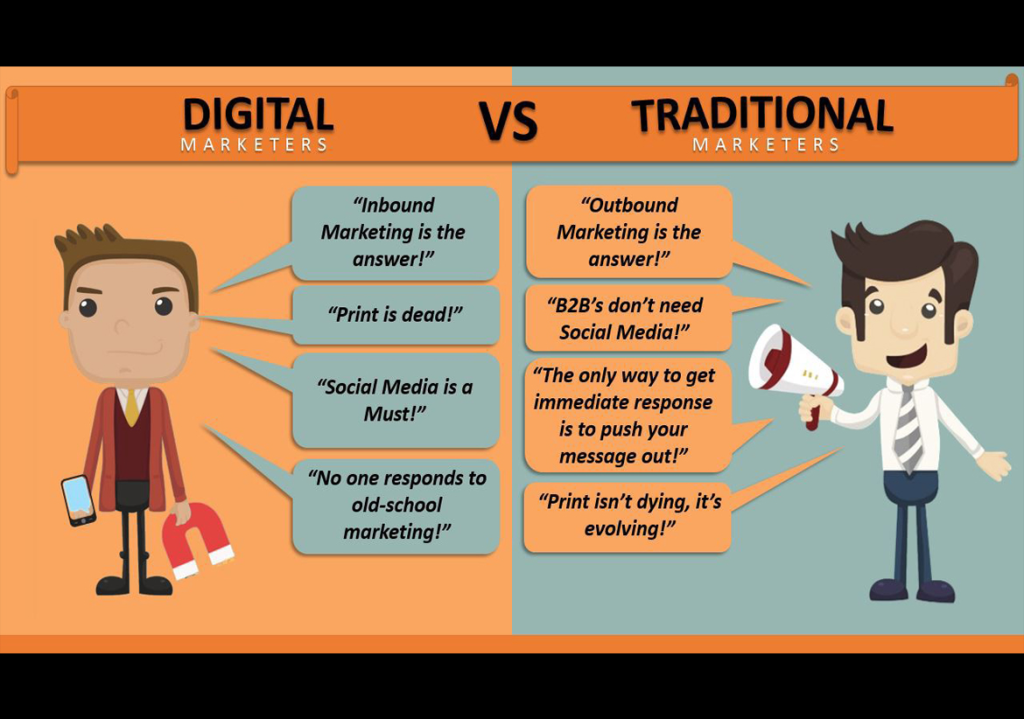What is Digital Marketing?

Digital marketing is the practice of promoting products or services through digital technologies, such as the internet, social media, search engines, mobile devices, and other digital channels. It involves a wide range of tactics and techniques that are designed to reach and engage target audiences, generate leads, and drive conversions.
Digital marketing includes various disciplines such as search engine optimization (SEO), search engine marketing (SEM), social media marketing, content marketing, email marketing, affiliate marketing, and mobile marketing. Each discipline has its own unique set of tools, strategies, and best practices, but they all share the goal of reaching and engaging with customers through digital channels.
What is traditional marketing?

Traditional marketing refers to the use of traditional media channels to promote products or services. These channels include print media such as newspapers, magazines, flyers, and billboards, broadcast media such as radio and television, and direct mail.
Traditional marketing often involves a one-way communication approach where the business sends a message to a broad audience. The goal of traditional marketing is to reach a large number of people through mass media channels and generate brand awareness and recognition.
Traditional marketing methods can be expensive, and it can be challenging to track their effectiveness. For example, it can be difficult to measure the number of people who saw a billboard or heard a radio ad and how many of them took action as a result.
Traditional marketing on the other hand involves traditional channels, like billboards and printed media. Think Don Draper in Mad Men brainstorming TV commercial ideas and copy for Coca-Cola.
How does digital marketing differ from traditional marketing?

The main difference between digital and traditional marketing is the medium through which an audience encounters a marketing message. While traditional marketing uses traditional media like magazines and newspapers, digital marketing uses digital media, such as social media or websites.
Here are the examples:
- Channels: Digital marketing uses digital channels, such as the internet, social media, email, search engines, mobile devices, and other digital media, to reach and engage customers. Traditional marketing, on the other hand, uses offline channels, such as print, television, radio, billboards, and direct mail.
- Targeting: Digital marketing allows for precise targeting of specific audiences based on demographics, interests, and behaviors, while traditional marketing is often more general and less targeted.
- Interactivity: Digital marketing allows for greater interactivity with customers through social media, email marketing, and other digital channels, while traditional marketing is often one-way communication from the business to the customer.
- Measurability: Digital marketing provides more accurate and measurable data on the effectiveness of marketing campaigns, such as website traffic, click-through rates, and conversion rates, while traditional marketing is often more difficult to track and measure.
- Cost: Digital marketing is often more cost-effective than traditional marketing, allowing businesses to reach a wider audience with less investment in resources and time.
What are the stages of traditional marketing?

Traditional marketing refers to the use of offline channels such as television, radio, print media, billboards, and direct mail to promote products or services.
- Define your target audience: Determine who your ideal customers are and their preferences. This will help you tailor your marketing strategies to reach them effectively.
- Develop a marketing plan: Create a marketing plan that includes your goals, budget, messaging, and tactics for each channel.
- Use print media: Use print media such as newspapers, magazines, brochures, flyers, and billboards to reach your target audience.
- Use broadcast media: Use broadcast media such as television and radio to reach a large audience and build brand awareness.
- Direct mail: Use direct mail to send promotional material such as flyers, brochures, or postcards directly to your target audience’s homes or businesses.
- Attend events: Attend trade shows, conferences, and other events related to your industry to network with potential customers and showcase your products or services.
- Measure your results: Use analytics to track the success of your traditional marketing efforts and adjust your strategies as needed.
How to run a campaign based on traditional marketing?

Running a successful campaign based on traditional marketing requires a well-thought-out plan that includes the following steps:
- Define your campaign goals: Determine what you want to achieve with your campaign, such as increasing brand awareness, generating leads, or driving sales.
- Identify your target audience: Understand your target audience’s demographics, interests, and behaviors. This will help you tailor your message to resonate with them.
- Develop your messaging: Develop a clear and compelling message that communicates the value of your product or service. Make sure it is consistent across all channels.
- Choose your marketing channels: Determine which marketing channels you will use to reach your target audience. Consider channels such as television, radio, print media, billboards, and direct mail.
- Set your budget: Determine how much money you are willing to spend on your campaign and allocate your budget accordingly.
- Create your campaign assets: Develop your campaign assets such as ads, flyers, brochures, or billboards. Make sure they are consistent with your messaging and brand.
- Launch your campaign: Launch your campaign across your chosen channels. Make sure to track your results and adjust your strategies as needed.
- Evaluate your campaign: Evaluate the success of your campaign by analyzing the results against your goals. Use this information to improve your future campaigns.
Thanks,






Leave a Reply
You must be logged in to post a comment.